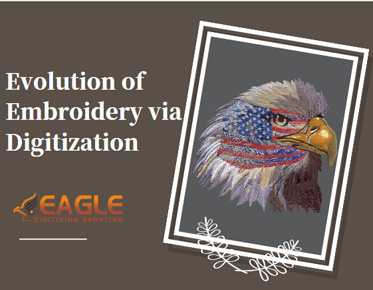Embroidery 101: Digital Image Conversion Tips
Embroidery is an ancient art form that has evolved with modern
technology, allowing us to digitize images and transform them into intricate embroidered designs. In this guide, we'll explore the
process of digitizing an image for embroidery,
from understanding the basics to mastering advanced techniques.
Understanding
the Basics of Image Digitization
Introduction to Image
Digitization for Embroidery
Image digitization for embroidery
involves converting a digital image into a format that can be stitched onto
fabric using an embroidery machine. This process requires specialized software
and a solid understanding of embroidery techniques and terminology.
Key Concepts and Terminology
Before diving into image digitization, it's essential to familiarize yourself with key concepts and terminology such as stitch types, stitch density, and underlay. Understanding these fundamentals will help you make informed decisions throughout the digitization process and achieve professional results.
Preparing
Your Image for Digitization
Selecting the Right Image for
Embroidery
Not all images are suitable for embroidery. When selecting an image,
consider factors such as complexity, level of detail, and color gradients.
Images with clear outlines and distinct features typically yield the best
results.
Tips for Image Preparation and
Editing
Before digitizing your image, it's crucial to prepare it properly. This may involve resizing, cropping, and adjusting contrast to enhance visibility and simplify the digitization process. Clean, high-quality images will produce better embroidery results.
Choosing
the Right Software for Digitization
Overview of Embroidery
Digitizing Software Options
There are numerous embroidery digitizing software options available,
each offering different features and capabilities. Popular choices include
Wilcom, Hatch, and Embird. Evaluate your needs and budget to determine the best
software for your projects.
Features to Look for in a
Digitizing Program
When choosing digitizing software, look for features such as automatic digitization tools, customizable stitch settings, and compatibility with various file formats. User-friendly interfaces and comprehensive tutorials can also streamline the learning process.
Importance
of Proper Stitch Types
Understanding Different Stitch
Types in Embroidery
Embroidery stitches come in various types, each serving a different
purpose and aesthetic. Common stitch types include satin stitch, fill stitch,
and running stitch. Understanding the characteristics and applications of each
stitch type is essential for achieving desired results.
Selecting the Appropriate Stitch
Type for Your Design
Choose the stitch type that best suits your design and desired effect. Satin stitch is ideal for smooth, continuous lines, while fill stitch is used to cover larger areas with solid color. Experiment with different stitch types to achieve the desired texture and visual impact.
Creating
a Digitization Plan
Planning Your Digitization
Process Step by Step
Before digitizing your image, create a digitization plan outlining the
steps you'll take and the techniques you'll use. Consider factors such as
thread colors, stitch direction, and underlay options to ensure a smooth and
successful digitization process.
Setting Realistic Expectations
and Goals
Digitizing images for embroidery requires time, patience, and practice. Set realistic expectations for your projects and be prepared to iterate and refine your designs as needed. Celebrate small victories and view challenges as opportunities for growth and learning.
Tracing
and Digitizing Your Image
Tracing Techniques for Image
Digitization
Tracing is the process of outlining and defining the shapes and
features of your image using digital drawing tools. Use your digitizing
software's tracing function to create clean, accurate outlines that will serve
as the foundation for your embroidery design.
Step-by-Step Guide to Digitizing
Your Image
Digitizing your image involves converting traced outlines into stitch data that your embroidery machine can interpret. Follow step-by-step tutorials and guides provided by your digitizing software to create and customize stitch settings for your design.
Adjusting
Stitch Density and Length
Importance of Stitch Density and
Length in Embroidery
Stitch density and length directly impact the appearance and
durability of embroidered designs. Properly adjusting these parameters ensures
that your stitches are neither too dense nor too sparse, resulting in balanced,
professional-looking embroidery.
Tips for Adjusting Stitch Parameters
for Optimal Results
Experiment with different stitch densities and lengths to achieve the desired coverage and texture for your design. Use lighter densities for delicate fabrics and finer details, and increase densities for denser fabrics and larger areas of color.
Adding
Embellishments and Details
Enhancing Your Digitized Image
with Embellishments
Embellishments such as beads, sequins, and metallic threads can add
depth and dimension to your embroidered designs. Use your digitizing software
to incorporate these embellishments strategically, taking care not to overwhelm
the design.
Incorporating Fine Details for a
Professional Finish
Fine details such as highlights, shadows, and textures can elevate your embroidery from ordinary to extraordinary. Pay attention to small details and nuances in your design, using different stitch types and densities to create depth and realism.
Testing
Your Digitized Design
Importance of Test Stitching
Your Design
Before stitching your design onto fabric, it's essential to test it on
a sample piece to ensure quality and accuracy. Test stitching allows you to
identify any issues or areas for improvement and make necessary adjustments
before committing to the final embroidery.
Troubleshooting Common Issues in
Digitized Images
Common issues in digitized images include thread breaks, puckering, and distortion. Troubleshoot these issues by adjusting stitch settings, thread tensions, and stabilizer types. Refer to your digitizing software's troubleshooting guide for solutions to common problems.
Refining
Your Digitized Image
Iterative Process for Refining
and Improving Your Design
Digitization is an iterative process that requires continuous
refinement and improvement. Take time to review your digitized design, seek
feedback from peers and experts, and make necessary revisions to enhance
clarity, accuracy, and visual appeal.
Fine-Tuning Details for
Precision and Clarity
Pay attention to details such as stitch direction, density transitions, and color blending to achieve precision and clarity in your embroidery. Use zoom and preview features in your digitizing software to inspect your design up close and make refinements as needed.
Optimizing
for Different Fabric Types
Considerations for Digitizing
Designs for Various Fabrics
Different fabrics have unique characteristics that can affect the
appearance and performance of embroidered designs. Consider factors such as
fabric weight, weave, and stretch when digitizing designs, and adjust stitch
settings accordingly to achieve optimal results.
Adjusting Settings for Different
Fabric Characteristics
Experiment with different stabilizers, needles, and thread types to accommodate various fabric types and textures. Use lighter stabilizers for delicate fabrics and heavier stabilizers for dense or stretchy fabrics to ensure proper tension and stitch quality.
Understanding
Copyright and Licensing
Respecting Copyright Laws and
Intellectual Property Rights
When digitizing images for embroidery, it's essential to respect
copyright laws and intellectual property rights. Obtain proper authorization
and licensing for copyrighted or trademarked designs, and refrain from using
unauthorized or pirated images in your embroidery projects. Be mindful of
intellectual property rights and seek permission or use royalty-free images to
avoid legal issues.
Obtaining Proper Licensing for
Digitized Designs
If you plan to digitize copyrighted or trademarked designs for commercial use, obtain proper licensing or permission from the copyright holder. Many designers and artists offer licensing agreements for their artwork, allowing you to legally digitize and use their designs for embroidery.
Saving
and Exporting Your Digitized Design
Best Practices for Saving and
Exporting Your Digitized Image
Once you've completed digitizing your image, save your work in a
compatible file format for your embroidery machine. Common embroidery file
types include .dst, .pes, .exp, and .jef. Choose the appropriate format based
on your machine's specifications and compatibility.
File Formats for Sharing and
Using Your Embroidery Design
In addition to saving your design for embroidery, consider exporting
it in other formats for sharing and backup purposes. JPEG and PNG formats are
suitable for sharing digital images online or printing promotional materials.
Maintain high-resolution versions of your design for future reference and
reproduction.
Backing
Up Your Work
Importance of Regularly Backing
Up Your Digitized Designs
Protect your digitized designs from loss or corruption by regularly
backing up your files. Store backup copies on external hard drives, cloud
storage services, or physical media to ensure redundancy and accessibility in
case of emergencies or data loss.
Strategies for Data Backup and Storage
Develop a systematic approach to data backup and storage to maintain organization and accessibility. Create folders and subfolders for different projects, versions, and file formats, and label them clearly for easy identification. Implement automated backup solutions to streamline the backup process and minimize the risk of human error.
Seeking
Feedback and Collaboration
Soliciting Feedback from Peers
and Experts
Seek feedback from fellow embroiderers, digitizers, and industry
experts to improve your skills and refine your designs. Join online forums,
social media groups, and community events to connect with like-minded
individuals, share knowledge, and exchange constructive criticism and advice.
Opportunities for Collaboration
and Learning in the Embroidery Community
Collaborate with other embroiderers and digitizers on joint projects, workshops, and events to expand your skills and network. Participate in collaborative challenges, group exhibitions, and skill-sharing sessions to gain exposure, build relationships, and learn from others in the embroidery community.
Mastering
Advanced Techniques
Exploring Advanced Digitization
Techniques and Tools
As you gain experience and confidence in image digitization, explore
advanced techniques and tools to take your skills to the next level. Experiment
with advanced features in your digitizing software, such as 3D effects, texture
mapping, and stitch sculpting, to create intricate and innovative designs.
Continuing Education and Skill
Development in Embroidery Digitization
Stay up to date with the latest trends, technologies, and techniques in embroidery digitization through continuous education and skill development. Attend workshops, seminars, and online courses offered by industry experts and software providers to expand your knowledge and expertise.
Troubleshooting
Common Issues
Common Problems Encountered in
Image Digitization
Despite your best efforts, you may encounter common issues such as
thread breaks, registration errors, and puckering in your digitized designs.
Troubleshoot these problems systematically by identifying the root cause and
implementing targeted solutions to address and resolve each issue.
Strategies for Addressing and
Resolving Digitization Challenges
Develop problem-solving strategies and workflows to effectively address and resolve digitization challenges as they arise. Consult troubleshooting guides, online tutorials, and technical support resources for assistance in diagnosing and resolving complex issues.
Promoting
Your Digitized Designs
Showcasing Your Digitized
Designs Online and Offline
Once you've digitized your designs, showcase them online and offline
to attract customers and generate interest in your work. Create a portfolio
website, social media profiles, and online marketplace listings to display your
designs and reach a wider audience.
Marketing Strategies for Selling
or Sharing Your Embroidery Designs
Implement marketing strategies such as social media marketing, email newsletters, and influencer collaborations to promote your digitized designs and attract potential buyers. Offer discounts, giveaways, and special promotions to incentivize sales and encourage customer engagement.
Embroidery digitization is a rewarding
and creative process that allows you to transform images into stunning
embroidered designs. By understanding the basics, mastering advanced
techniques, and embracing collaboration and feedback, you can elevate your
digitization skills and create captivating designs that delight customers and
showcase your talent. Celebrate your journey in image digitization for
embroidery, and look ahead to future projects and opportunities for growth and
innovation in this dynamic and evolving field.



